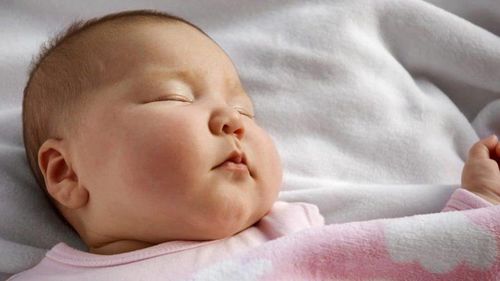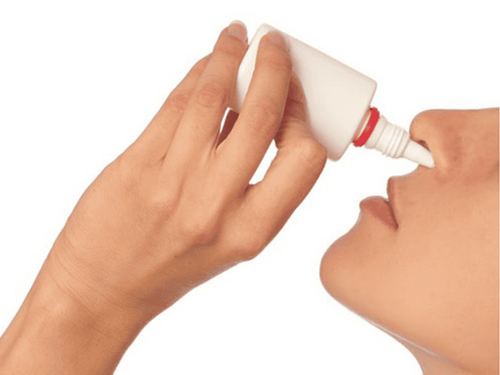This is an automatically translated article.
Posted by Doctor Le Tuyet Nga - Pediatric Center - Vinmec Times City International General Hospital.Pneumonia in children is a disease caused by bacteria, viruses, fungi and parasites. Germs can be spread from sick children, from adult carriers, from the environment to children. The disease has very severe forms, rapid progression that can be fatal if not detected early and treated promptly.
According to statistics of the World Health Organization (WHO), pneumonia is the leading cause of death in children under 5 years of age. Every year, in Vietnam, up to one third of child deaths are due to pneumonia. The disease can be contagious, but it can also be prevented by some specific measures.
1. Signs of pneumonia in children parents need to know
Moderate to severe cough, usually severe, but not necessarily. Continuous rapid breathing (different from temporary rapid breathing when the child has a high fever). Children are considered tachypnea if they breathe more than 60 times / minute (for children under 2 months old), more than 50 times / minute (for children from 2 months to 1 year old) or more than 40 times / minute (for children over 1 year old). year old). Count breaths while the child is lying still and inactive. Use a watch with a second hand to count to 1 minute. Exercising breathing: nasal flaps, moaning, intercostal muscle contraction (the soft position between the ribs is concave when the child breathes in), retraction of the sternum, chest indrawing. Rapid breathing and labored breathing are compensatory responses, but the child's body can't keep trying. If not treated promptly, the child may have respiratory failure, exhaustion, slow breathing and then stop breathing. Fever is moderate to high but sometimes absent in children with weakened immune systems. Chest pain during coughing and also between coughs. Vomiting not only after strong coughs but also between coughs. Cyanosis around the lips and face due to lack of oxygen in the child. Stridor, although stridor is more often a sign of a viral infection, it can also sometimes be a sign of pneumonia. If your child has some of the above symptoms, it is likely that he or she has pneumonia. The most important are the three symptoms of cough, fever and rapid or labored breathing.

Một số trẻ có thể xuất hiện tình trạng sốt cao
2. Evaluation of pneumonia based on what symptoms?
+ First: Rapid breathing is the sign with the highest diagnostic value for pneumonia.
Parents or relatives can count breathing when the child is lying still or sleeping and must count for 1 minute, if you want accurate results, count 2-3 times. If the child has severe pneumonia, there will be signs of chest indrawing. To detect this sign, look at the lower part of the ribcage (1/3) that is recessed when the child inhales. Note that only soft midrib or supraclavicular retraction is not indicative of thoracic indrawing.
On the other hand, in children under 2 months of age, if only slight chest indrawing is not valid, it is not classified because the chest of young children is still soft, so when breathing normally, it may be slightly indented. Therefore, in these children, strong chest indrawing (deep and easily visible) is valuable for the diagnosis of pneumonia.
+ Another common symptom is high fever.
+ The symptoms of nasal fluttering, moaning, poor feeding, irritability and other abnormalities.
The diagnosis of pneumonia in children should be based on the above clinical symptoms.
Very severe pneumonia with symptoms: the child has a cough or difficulty breathing plus at least one of the main symptoms is: cyanosis, convulsions, lethargy or coma; unable to drink or stop feeding or vomiting everything; Severe respiratory failure with head nodding with breathing and contractions of accessory respiratory muscles. In addition, there may be a number of other symptoms including: rapid breathing, rising and falling of the nostrils, moaning, and chest tightness. Severe pneumonia: the child coughs or has difficulty breathing and has at least one of the main symptoms: chest tightness, rising and falling of the nose; grunting (in infants younger than 2 months) and no major signs of very severe pneumonia. In addition, the child may also have some of the other symptoms described in very severe pneumonia. Pneumonia is not severe: children with cough or shortness of breath and shortness of breath, children under 2 months: breathing rate about 60 times/minute; children from 2-12 months: breathing rate about 50 times/minute; children from 12 months to 5 years old: breathing rate is about 40 times/minute; but do not have one of the main symptoms of severe or very severe pneumonia.
3. Factors that cause pneumonia
3.1 Bacterial pneumonia Bacterial pneumonia is usually transmitted by droplets (when a healthy person inhales or swallows bacteria-filled droplets after an infected person coughs or sneezes). People with weakened immune systems and people with chronic medical conditions are more susceptible to bacterial pneumonia than the general population. Common signs and symptoms of bacterial pneumonia include:
Cough sputum Fever over 38 degrees C Rapid breathing Shortness of breath Chest pain Fatigue

Trẻ sốt cao và mệt mỏi do viêm phổi
3.2 Viral pneumonia The signs and symptoms of viral pneumonia are quite similar to those of the flu, including:
Fever Chills, chills Dry cough, but can superinfect and become a cough phlegm Runny nose Muscle pain Headache Weakness, fatigue Symptoms can range from mild to severe.
3.3 Fungal pneumonia Fungi are a less common cause of pneumonia. If you are immunocompromised for any reason, your chances of developing fungal pneumonia are increased.
Fungal pneumonia is caused by inhalation of fungal spores, so certain occupations have a higher risk of being exposed to fungal spores
Pneumonia signs and symptoms Fungal infection is similar to pneumonia caused by other causes (such as fever, cough,...)
4. Preventive measures
Pneumonia can occur all year round, but is most common in winter and spring due to cold weather, reduced human resistance along with influenza viruses that have the opportunity to develop and cause disease in humans.According to research, some influenza viruses will not grow when the temperature is above 30oC, that's why pneumonia is less common in summer and autumn. Moreover, pneumonia is often a complication of upper respiratory tract infections such as inflammation of the nose, throat, sinuses...
In winter, colds also increase, making viruses and bacteria take advantage of the opportunity to invade the nasopharynx and down. lungs causing pneumonia.
In order to prevent pneumonia in children, it is necessary to take the following measures:
The first thing is still to provide children with adequate nutrients, and to breastfeed many times a day. The living environment must be clean and hygienic to avoid inhaling dust and irritants. Daily hygiene for children's teeth clean twice a day in the morning when they wake up and at night before going to bed, after each meal, give them a mouthwash to prevent bacteria from remaining by brushing and wiping their teeth. small. Early examination and treatment of ENT, oral and maxillofacial diseases for children, especially children under 5 years old, to avoid bacterial infections. Fully vaccinated against vaccines in the expanded program of immunization. In winter, it is necessary to wear warm enough clothes for the child, pay attention to keep the chest, neck, and face warm for the child, especially when taking the child out.

Cha mẹ nên đưa trẻ đến trung tâm y tế uy tín để được tiêm chủng đầy đủ
Wash hands with soap before and after eating Avoid contact with sick people Do not share living utensils with sick people Keeping the living environment clean For pregnant women: screening for birth defects, monitoring and reasonable health care, avoiding cases of premature birth, malnutrition, and underweight. For timely diagnosis and treatment, avoid further progression leading to dangerous complications. Avoid contact with people with acute respiratory diseases. When you need to come into contact with sick people, you must wear a medical mask and keep a distance when in contact. When coughing or sneezing, cover your mouth and nose with a cloth or handkerchief to reduce the spread of respiratory secretions, then destroy or wash the tissue immediately. Regularly gargle with an antiseptic solution. Increase ventilation in workplaces, homes, schools, medical facilities,... by opening doors and windows, and limiting the use of air conditioners. Regularly wipe floors, doorknobs and surfaces of household objects with common cleaning agents, such as soap and disinfectant solutions, the Pediatrics Department at Vinmec International General Hospital is the address receive and examine the diseases that infants as well as young children are susceptible to: viral fever, bacterial fever, otitis media, pneumonia in children, ....With modern equipment, clean space infection, minimizing the impact as well as the risk of disease transmission. Along with that is the dedication from the doctors with professional experience with pediatric patients, making the examination no longer a concern of the parents.
Please dial HOTLINE for more information or register for an appointment HERE. Download MyVinmec app to make appointments faster and to manage your bookings easily.













